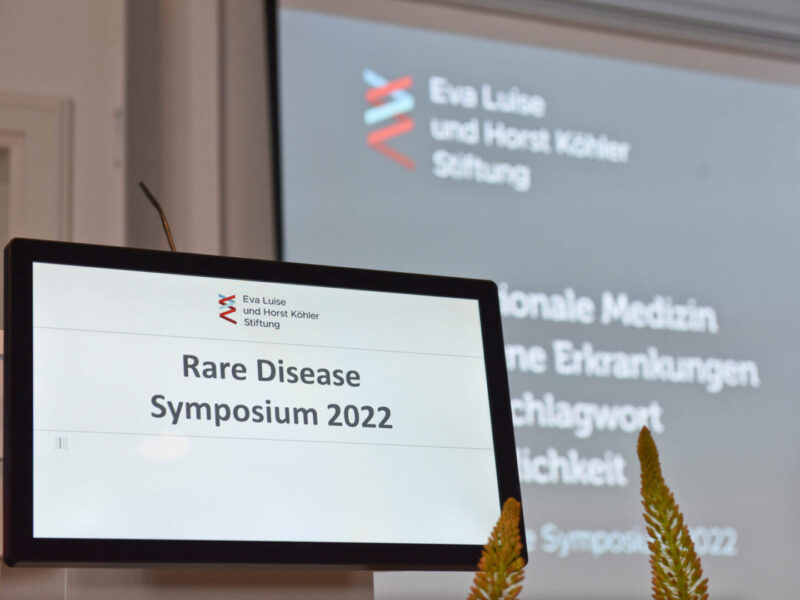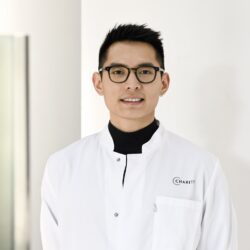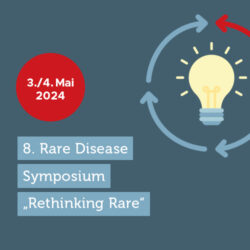Rückblick auf das 6. Rare Disease Symposium 2022
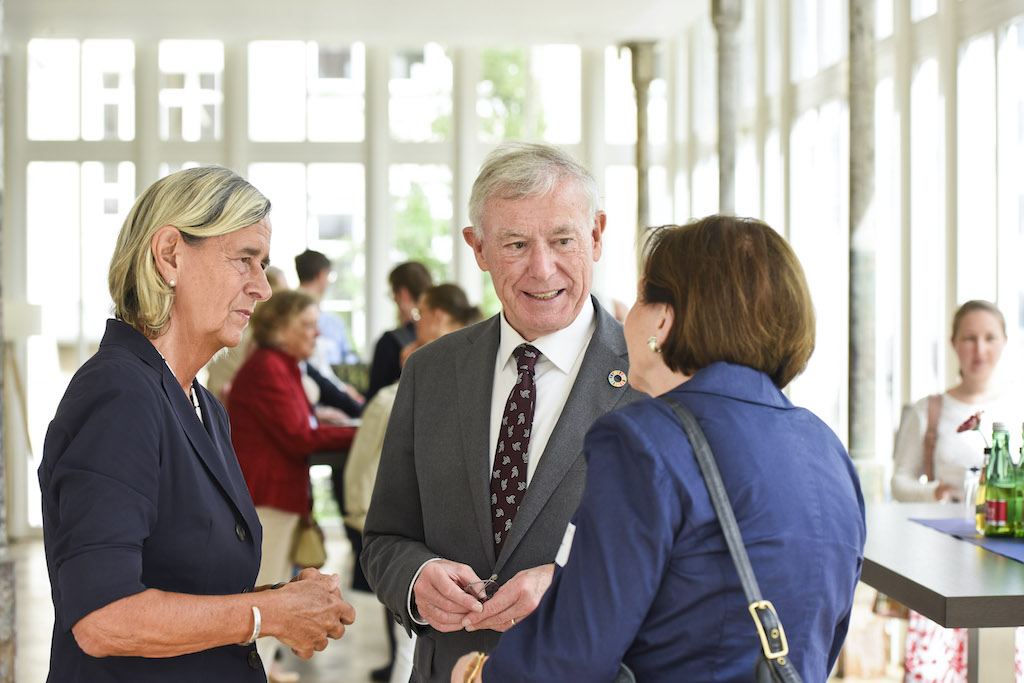

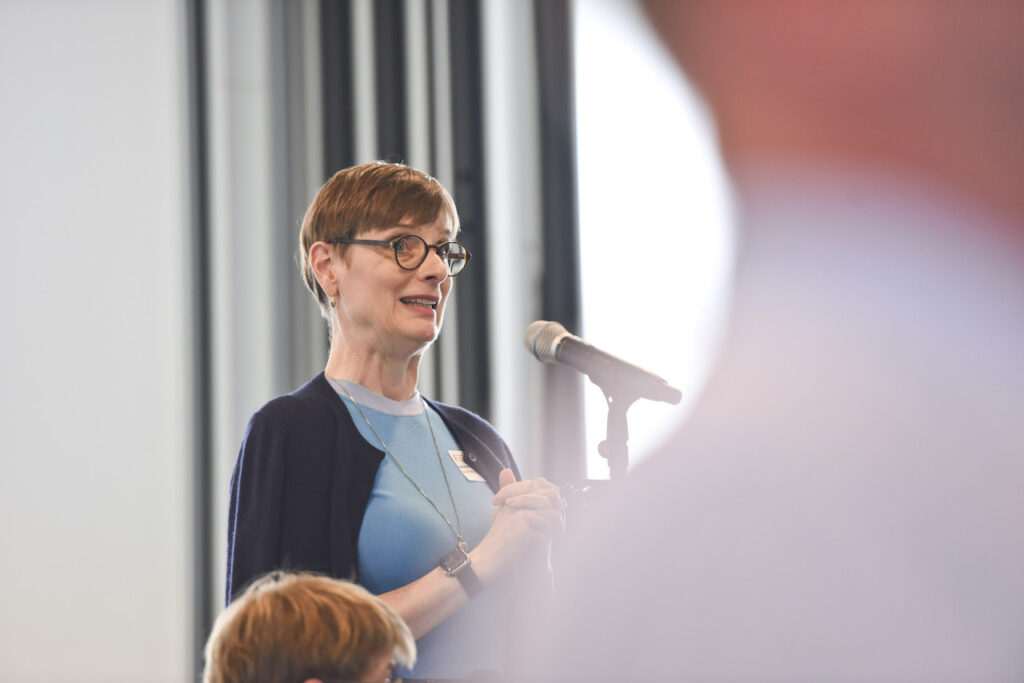

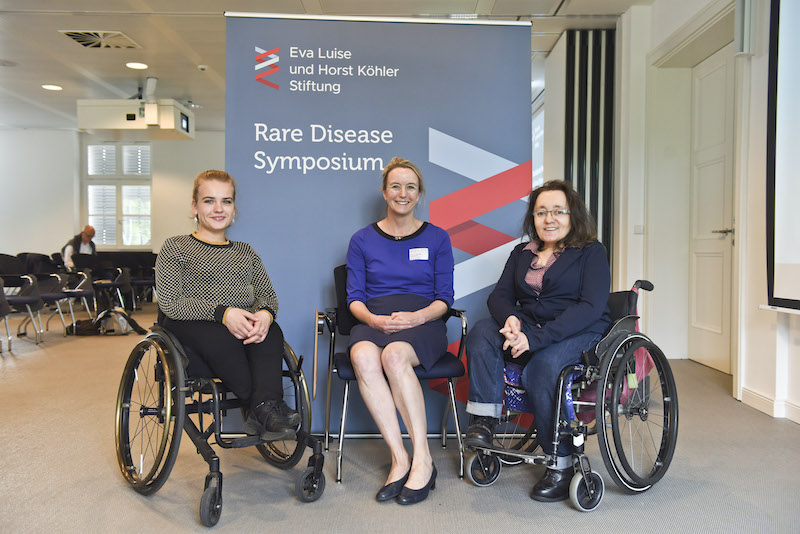
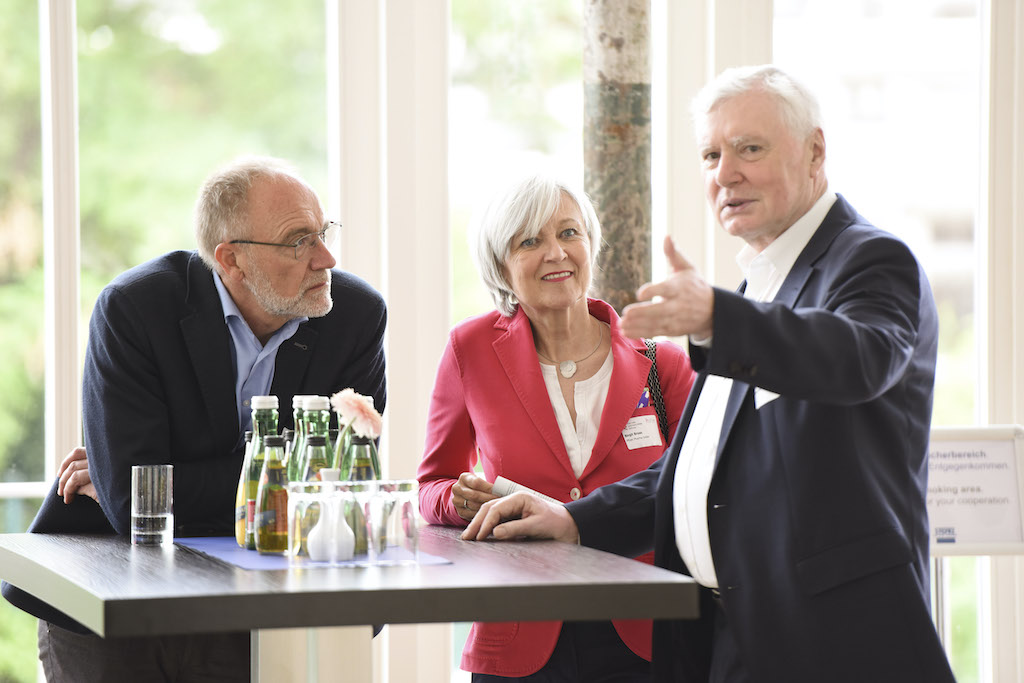
Wie wird aus grundlagenwissenschaftlichem Erkenntnisgewinn medizinischer Fortschritt? Was ist notwendig, damit Patientinnen und Patienten zügig von Forschungsergebnissen profitieren?
Zum Austausch über diese und weitere Fragestellungen rund um das Thema Translationale Medizin hatte die Eva Luise und Horst Köhler Stiftung für Menschen mit Seltenen Erkrankungen am 13. und 14. Juni 2022 zum 6. Rare Disease Symposium nach Berlin eingeladen. Rund 100 Gäste, die sich aus beruflichem Interesse oder aus persönlicher Betroffenheit mit Seltenen Erkrankungen befassen, waren der Einladung gefolgt. Deutlich war zu spüren, wie wichtig und wohltuend das persönliche Zusammenkommen und der direkte Austausch nach einem Jahr pandemiebedingter Pause war.
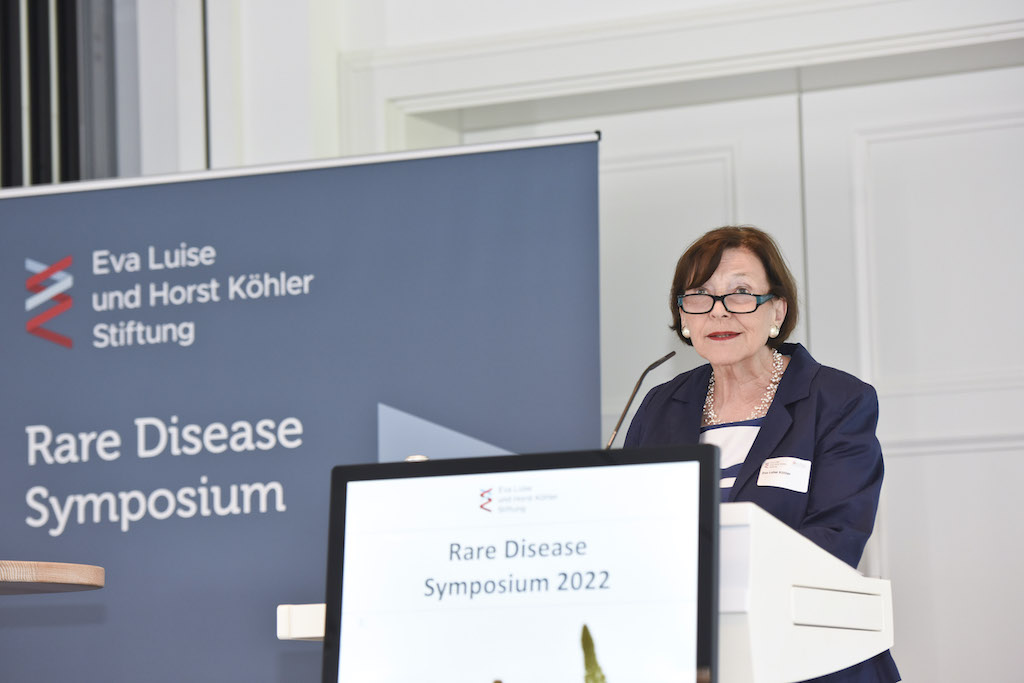
Unter dem Titel “15 Jahre gemeinsames Wirken” nahm Eva Luise Köhler in ihrem eröffnenden Grußwort eine Standortbestimmung für die Seltenen Erkrankungen vor. Sie benannte wichtige Meilensteine wie die Gründung von NAMSE, dem Nationalen Aktionsbündnis für Menschen mit Seltenen Erkrankungen im Jahr 2010, oder die Einrichtung von mittlerweile 37 Zentren für Seltene Erkrankungen in Deutschland und deren Zertifizierung, mahnte jedoch auch weitere Anstrengungen an. Vielfältige innovative Projekte und Initiativen wie genomDE, die Medizininformatik Initiative CORD-MI, das EU-Forschungsprojekt Screen4Rare oder NARSE, das Nationale Register für Seltene Erkrankungen, müssten nun gebündelt, die Kräfte und Ideen zusammengeführt und als gemeinsame Bewegung so umgesetzt werden, dass sie den Patientinnen und Patienten den größten Nutzen bringen. “Verbunden werden auch die Schwachen mächtig”, zitierte Eva Luise Köhler Friedrich Schiller und appellierte an das Publikum, gemeinsam daran zu arbeiten, diese Worte mit Leben zu füllen und Verbundenheit zu schaffen “für die Wenigen, die doch so Viele sind”.

Den Auftakt zur anschließenden Vortragsreihe machte Prof. Dr. Christopher Baum, Vorsitzender des Direktoriums des Berlin Institut of Health (BIH). Unter dem Titel “Translation. Ein Zauberwort der Zukunft oder bereits Realität?” verortete er den Begriff Translation als verbindendes Element im Dreiklang aus Heilen, Lehren und Forschen. Anhand der Charité-Strategie erläuterte Prof. Baum, wie das Ziel eines relevanten medizinischen Nutzens für Patient*innen und Bürger*innen durch ein organübergreifendes Verständnis von Gesundheit und Krankheit über den gesamten Behandlungsprozess hinweg mitgedacht wird. Dabei eröffnen Entwicklungen wie die digitale Revolution, neue Technologien und innovative Ansätze in Diagnostik und Therapieentwicklung auf zellulärer Ebene fundamental neue Möglichkeiten, um den Herausforderungen durch die hohe Komplexität der translationalen Wertschöpfungskette erfolgreich zu begegnen.
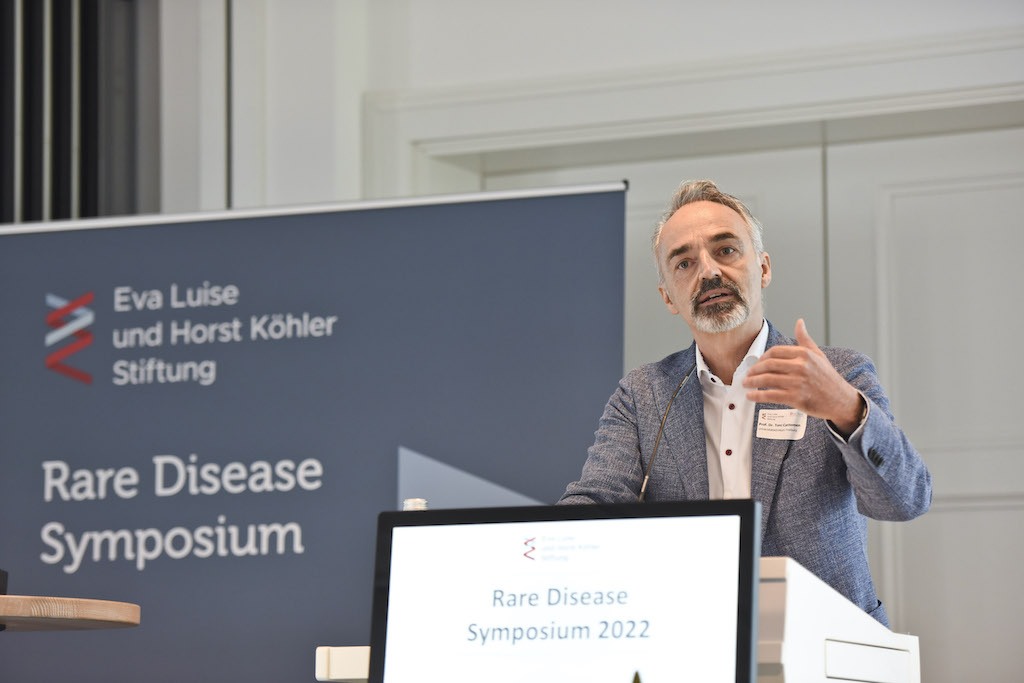
Prof. Dr. Toni Cathomen, Direktor des Centrums für Chronische Immundefizienz
und des Instituts für Transfusionsmedizin und Gentherapie des Universitätsklinikums Freiburg gab im anschließenden Vortrag “Gene Editing – Superkraft der Translation?” einen Überblick über die rasante Entwicklung und den aktuellen Stand der Gentherapie. Er stellte verschiedene Therapieansätze vor und skizzierte deren Einsatzmöglichkeiten am Beispiel der Genschere Crispr Cas. Den Ausblick auf das zu erwartende starke Wachstum des Bereichs der Gentherapie-Produkte innerhalb der nächsten Jahre verknüpfte Prof. Cathomen mit einem kritischen Blick auf die Situation in Deutschland, wo eine starke Forschungslandschaft zu oft von bürokratischen Hürden und fragmentierten Strukturen gebremst wird.
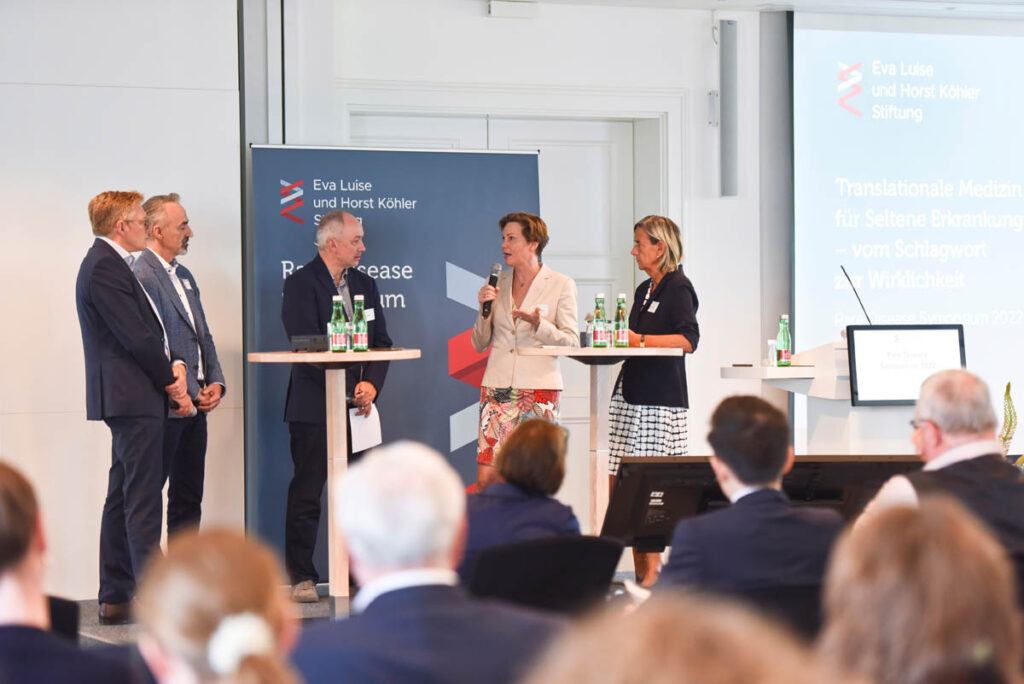
Beim anschließenden, vom ZEIT-Redakteur Martin Spiewak moderierten Roundtable diskutierten Prof. Dr. Christopher Baum, Prof. Dr. Toni Cathomen, Prof. Dr. Annette Grüters-Kieslich, Vorsitzende der Eva Luise und Horst Köhler Stiftung, und Prof. Dr. Eva Winkler vom Nationalen Centrum für Tumorerkrankungen Heidelberg, wie Translation trotz verdichteter Arbeitsprozesse, ökonomischer Orientierung und erst im Aufbau befindlicher IT-Standards und -Strukturen besser gelingen kann. Während der Stand der Translation in Deutschland unterschiedlich bewertet wurde, bestand Einigkeit darüber, dass für gelingende Translation ein enger Schulterschluss von Forschung und Versorgung unabdingbar ist. Frau Prof. Grüters rief dazu auf, das Silodenken in der Universitätsmedizin zu überwinden. Die sei in Deutschland der einzige Ort mit Strukturen, die gleichzeitig eine erkenntnisbasierte und patientenorientierte Forschung ermöglichen und diese sinnvoll mit Grundlagenforschung und der klinischen Entwicklung innovativer Therapien verbinden. Prof. Baum verwies auf die Notwendigkeit einer frühzeitigen Identifikation geeigneter Partner wie etwa den Deutschen Zentren für Gesundheitsforschung (DZG), dem Nationalen Centrum für Tumorerkrankungen (NCT) und dem Berlin Institute of Health (BIH) bis hin zu (inter)nationalen Netzwerken. Dabei müssten wissenschaftliche, technische und regulatorische Dimensionen immer mitgedacht werden. Alle stimmten überein, dass neben der Bereitstellung ausreichender finanzieller Mittel die frühzeitige Einbindung der Patientinnen und Patienten beziehungsweise ihrer Interessenvertretungen entscheidend ist für den Erfolg der Translation.
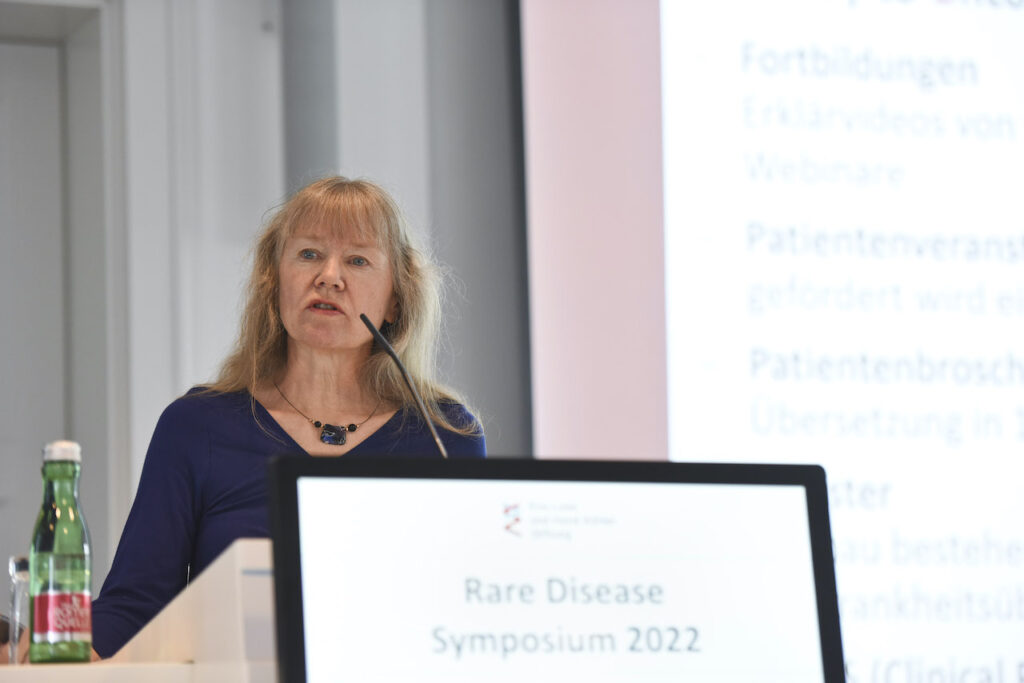
Zum Auftakt des Nachmittags unterstrich Dr. Ruth Biller, Vorsitzende des ARVC Selbsthilfe e.V., die große Bedeutung von Netzwerken für die Vertretung der Interessen von Menschen mit Seltenen Erkrankungen. Anhand persönlicher Erfahrungen in der Patientenvertretung im Bereich der seltenen Herzerkrankungen hob sie die Bedeutung der 24 Europäischen Referenznetzwerke (ERN) hervor, die sich seit 2017 mit dem Ziel “Share – Care – Cure“ für verschiedene Seltene Erkrankungen engagieren. Frau Dr. Biller erläuterte die wichtige Rolle ihres Netzwerks für seltene Herzerkrankungen ERN GUARD-Heart und der Europäischen Dachorganisation EURORDIS bei der Vernetzung von Betroffenen und Ärzt:innen sowie die Unterstützung der European Patient Advocacy Groups, die dringend erforderliche Beteiligung von Patientenvertreter:innen an der Entwicklung von Leitlinien, Registern und Forschungsprojekten organisieren. Mit Blick auf eine Verbesserung der Situation in Deutschland plädierte Frau Dr. Biller für mehr Digitalisierung im Gesundheitswesen, die Erstellung nationaler oder mindestens eine Beteiligung an internationalen Registern, die Ausweitung genetischer Untersuchungen und Obduktionen sowie eine adäquate Finanzierung der Zentren für Seltene Erkrankungen.
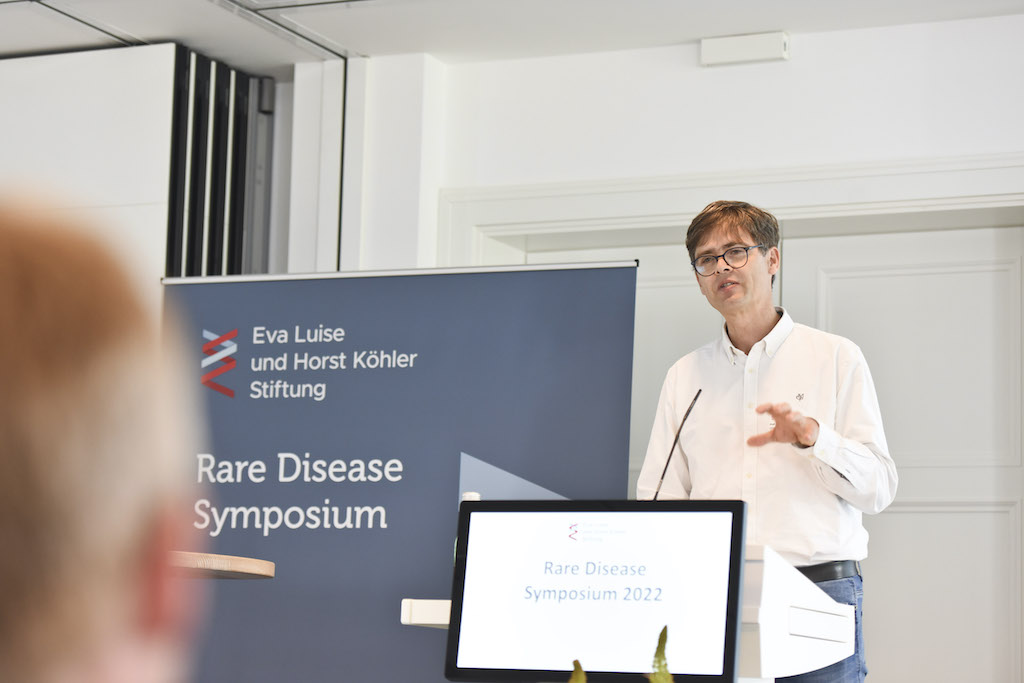
Prof. Dr. Stephan Ehl, Direktor des Instituts für Immundefizienz am Centrum für Chronische Immundefizienz (CCI) des Universitätsklinikums Freiburg, zeigte anschließend die Bedeutung von (inter)nationalen Konsortien am Beispiel der Immundefekte auf. Rückblickend auf verschiedene Stationen seines beruflichen Lebens erläuterte er aus der Perspektive des Kinderarztes und Immunologen, welche Aspekte für die erfolgreiche Behandlung “medizinischer Kolibris” entscheidend sind: Neben Interdisziplinarität seien dies besonders eine enge Zusammenarbeit von Forschung und Klinik sowie die Schaffung translationaler Strukturen, indem der Therapiebereich bereits im Rahmen der Forschung mitgedacht wird. Als Beispiel einer erfolgreichen Zusammenarbeit führte er das vom Bundesministerium für Bildung und Forschung zwischen 2008 und 2018 geförderte Projekt der Integrierten Forschungs- und Behandlungszentren (IFB) an. Mit Blick auf künftige Programme sprach sich Prof. Dr. Ehl für längere Förderperioden aus, da nachhaltige Vernetzung Zeit benötigt.

Dr. Alexander Lehmann, verantwortlich für die Kolleg-Förderlinien der Else Kröner-Fresenius Stiftung (EKFS), die sich neben der Unterstützung internationaler medizinischer Projekte in erster Linie der Förderung medizinischer Wissenschaft verpflichtet hat, gab einen Überblick über die Förderansätze der Stiftung. Als Brücke zwischen Forschung und Klinik fördert die EKFS aktuell 28 Forschungskollegs von Clinician Scientists, darunter zwei gemeinsam mit der Eva Luise und Horst Köhler Stiftung geförderte Kollegs im Bereich der Seltenen Erkrankungen. Dr. Lehmann unterstrich die Schlüsselrolle von Clinician und Medical Scientists für den Erhalt der Innovationskraft in der Universitätsmedizin. Durch standort- und fächerübergreifende Vernetzung, einen Austausch von Methoden und Erfahrungen und gemeinsame Publikationen tragen die Programme konkret zur Verbesserung der anwendungsbezogenen und patientenorientierten medizinischen Forschung bei.
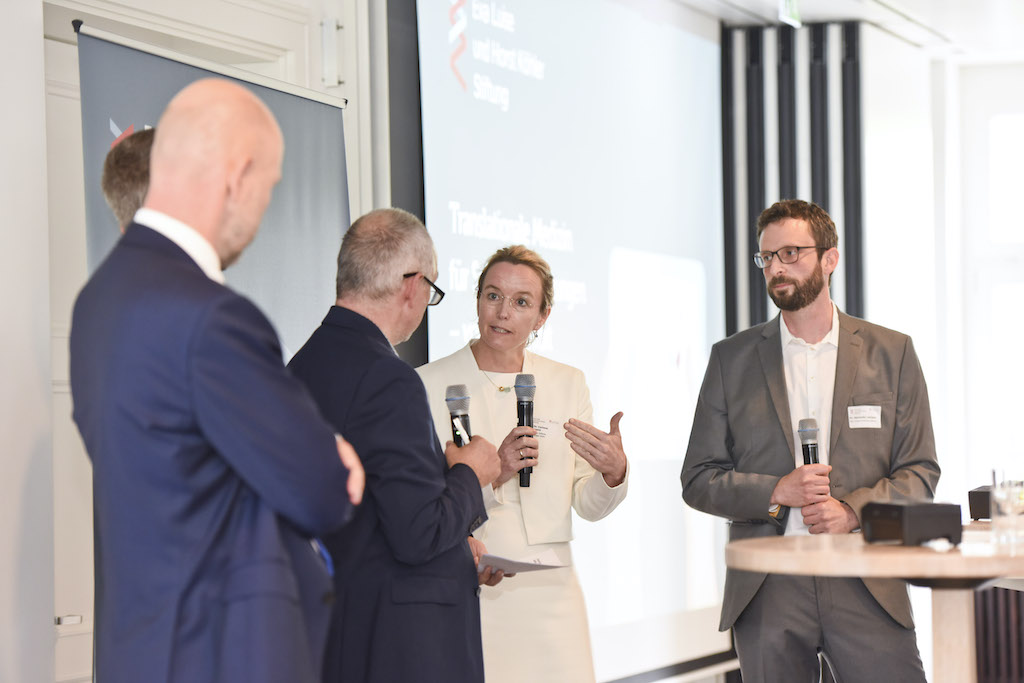
Zum Abschluss des ersten Symposium-Tages tauschten sich Markus Algermissen, Leiter der Unterabteilung 31 Medizin- und Berufsrecht im Bundesministerium für Gesundheit, Prof. Dr. Reinhard Berner, Direktor der Klinik für Kinder- und Jugendmedizin des Universitätsklinikums Dresden, Prof. Dr. Corinna Grasemann, Leiterin des Centrums für Seltene Erkrankungen Ruhr und Vorsitzende von NAMSE Netz e.V., und Dr. Alexander Lehmann von der Else Kröner Fresenius Stiftung unter der Moderation von Martin Spiewak, über Forschungsvernetzung in der Praxis aus. In der Diskussion wurde deutlich, dass es im Bereich der Seltenen Erkrankungen ein Miteinander von “Top Down”- Ansätzen wie dem im Koalitionsvertrag festgeschriebenen Registergesetz und “Bottom Up”-Bewegungen wie NAMSE Netz e.V. braucht, das als Verein die Einrichtung, Weiterentwicklung und Vernetzung von Zentren für Seltene Erkrankungen fördert und deren Zertifizierung auf den Weg gebracht hat. Vernetzung spielt dabei eine wesentliche Rolle – nicht nur von Einrichtungen und Personen, sondern auch von Daten innerhalb des Gesundheitssystems. So hat beispielsweise das vom Bundesministerium für Gesundheit (BMG) in Auftrag gegebene Registergutachten, das im Dezember 2021 vorgestellt worden ist, bereits zu einer besseren Vernetzung der vielen Registerbetreibenden im Bereich der Seltenen Erkrankungen geführt, wie Markus Algermissen ausführte. Personell gut aufgestellte Zentren für Seltene Erkrankungen, langfristige Perspektiven für motivierte Ärztinnen und Ärzte, die sich in Klinik und Forschung engagieren möchten, sowie starke Verbünde wie TRANSLATE-NAMSE erfolgreich vorgelebt hat sind nach Ansicht der Runde unentbehrliche Modelle der Zukunft für eine erfolgreiche Translation.
Zum Auftakt des zweiten Symposium-Tages gab Prof. Dr. Peter Krawitz, wissenschaftlicher Vorstand und Vorstandsvorsitzender des Instituts für Genomische Statistik und Bioinformatik (IGSB), einen Überblick über neue Möglichkeiten in der Diagnostik durch Exom- und Genomanalyse sowie computergestütztes Phenotyping durch Face2Gene bzw. GestaltMatcher. Zudem erläuterte er in Vertretung von Prof. Dr. Heiko Krude Ergebnisse des Innovationsfonds-Projekt TRANSLATE-NAMSE, an dem das Uniklinikum Bonn als Standortpartner beteiligt war. In dem dreijährigen Verbundprojekt von neun Zentren für Seltene Erkrankungen und vier humangenetischen Instituten in Kooperation mit zwei Konsortialkrankenkassen sowie der Allianz Chronisch Seltener Erkrankungen (ACHSE) e.V wurden zentrale Maßnahmenvorschläge aus dem Nationalen Aktionsplan bundesweit umgesetzt und in Hinblick auf eine Übernahme in die Regelversorgung erfolgreich erprobt. Während in TRANSLATE-NAMSE dank Exom-Sequenzierung in gut einem Drittel der Fälle eine Diagnose, darunter viele ultra-seltene, gestellt werden konnten und allein 28 neue Krankheitsentitäten beschrieben wurden, wird die Zukunft Prof. Krawitz zufolge im Bereich der Genom-Sequenzierung und Multi-Omics-Verfahren liegen
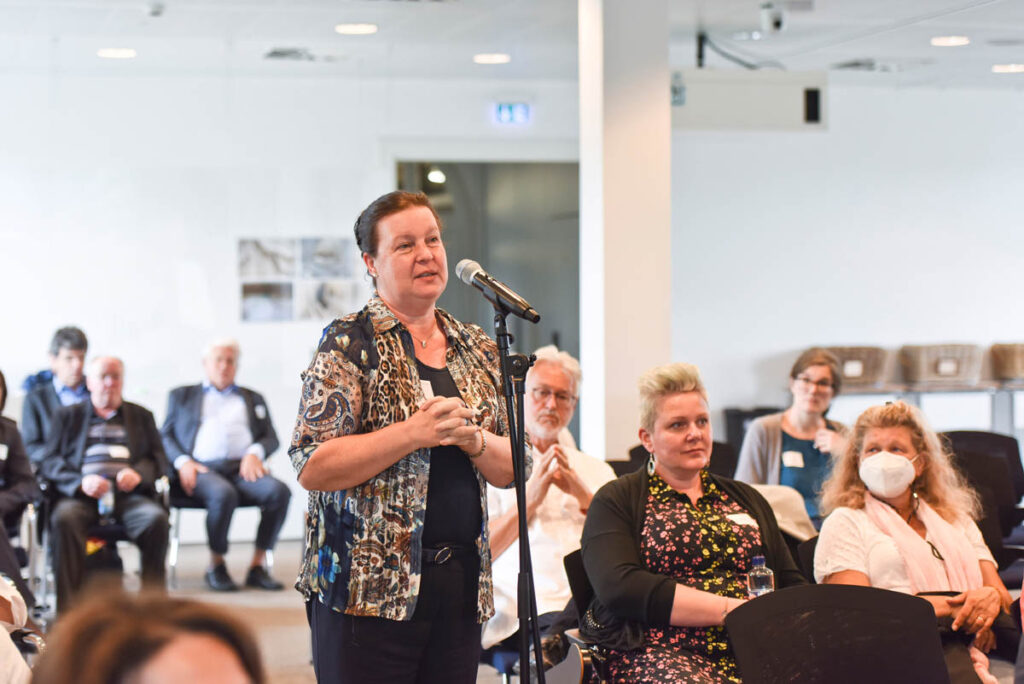
Gabriele Müller vom Zentrum für Evidenzbasierte Gesundheitsversorgung (ZEGV) der TU Dresden, das gemeinsam mit der Berlin School of Public Health (BSPH) für die Evaluation von T-NAMSE verantwortlich war, stellte im Anschluss Projektergebnisse aus Sicht der Patient:innen und der Versorgungsforschung vor. Sie zeigte auf, dass im Rahmen von T-NAMSE bei rund 30% der 5600 teilnehmenden Patient:innen eine gesicherte Diagnose gestellt werden konnte, wobei das Spektrum der Diagnosen sehr breit war und etwa ein Viertel dieser Diagnose nur ein einziges Mal gestellt wurden. Ein wesentliches Ergebnis war, dass T-NAMSE durch interdisziplinäre, standortübergreifende Fallkonferenzen, den Einsatz von Lotsen sowie innovativer (genetischer) Diagnostik die Diagnosestellung deutlich beschleunigen konnte: Im Schnitt betrug dieser im Projekt etwa ein halbes Jahr, während Kinder zuvor vier, Erwachsene mehr als acht Jahre ohne Diagnose waren. Dass über 80% der befragten Patient:innen mit einer Diagnose die Hoffnung auf eine Therapie verknüpfen, unterstreicht die Bedeutung der strukturierten Versorgung. Entsprechend wichtig für Menschen mit Seltenen Erkrankungen ist die kürzlich ausgesprochene Empfehlung einer Überführung der T-NAMSE-Projektinhalte in die Regelversorgung durch den Innovationsausschuss beim Gemeinsamen Bundesausschuss (G-BA).
Unter dem Titel “Register: Bottom Up Lösungen für Menschen mit Seltenen Erkrankungen” gaben Prof. Dr. Holger Storf, Leiter des Instituts für Medizininformatik am Universitätsklinikum Frankfurt und seine Kollegin Dr. Alexandra Berger vom Zentrum für Seltene Erkrankungen anschließend einen Überblick über den Stand von Registerprojekten im Bereich der Seltenen Erkrankungen und zeigten auf, wie der Prozess der Registererstellung von der Planung bis zum Aufbau durch IT- Unterstützung erleichtert und optimiert werden kann. So bietet das Open-Source-Registersystem für Seltene Erkrankungen (OSSE) eine generische Software für die Erstellung von Patientenregistern mit hohen Datenqualitätsstandards, die auf die Bedürfnisse von Seltenen Erkrankungen zugeschnitten ist. Konkret zeigte Frau Dr. Berger am Beispiel der Register für Patienten mit unklarer Diagnose bzw. ohne Diagnose auf, wo Chancen und Herausforderungen von Registern im Bereich der Seltenen Erkrankungen liegen. Auf Grundlage von Erkenntnissen im Rahmen eines am Frankfurter ZSE aufgesetzten retrospektiven Registers soll mit dem Ziel der Vernetzung, verbesserten Versorgungsforschung und ERmöglichung von Musteranalysen ein prospektives Register aufgesetzt werden. Alle Zentren sind herzlich eingeladen, daran mitzuwirken. Denn auch bei Registern gilt: Gemeinsam kann man mehr erreichen!
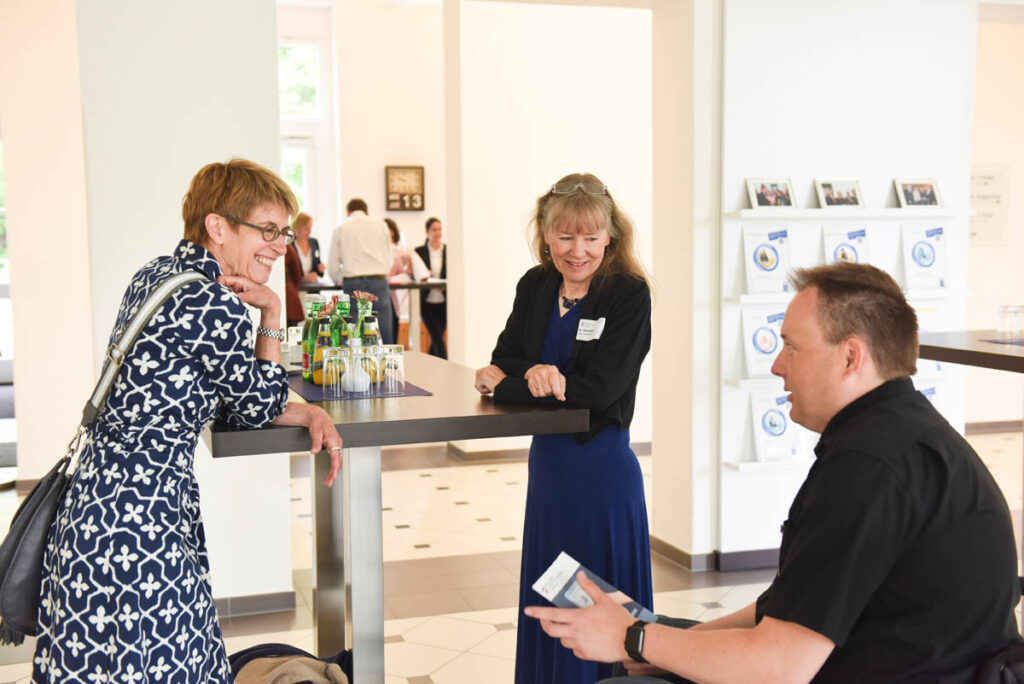
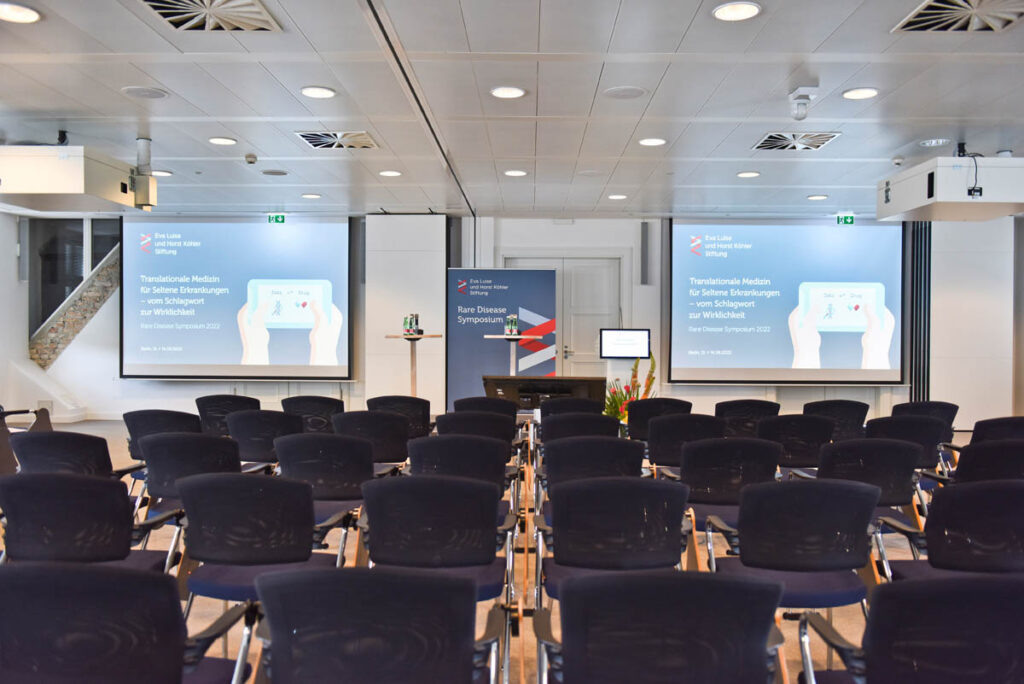
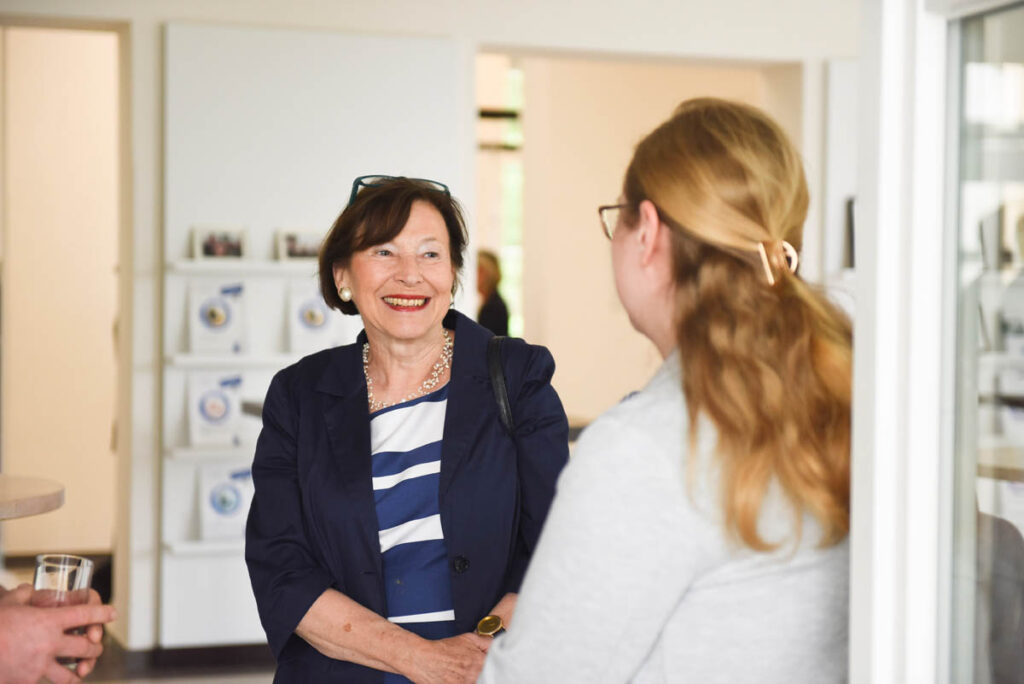
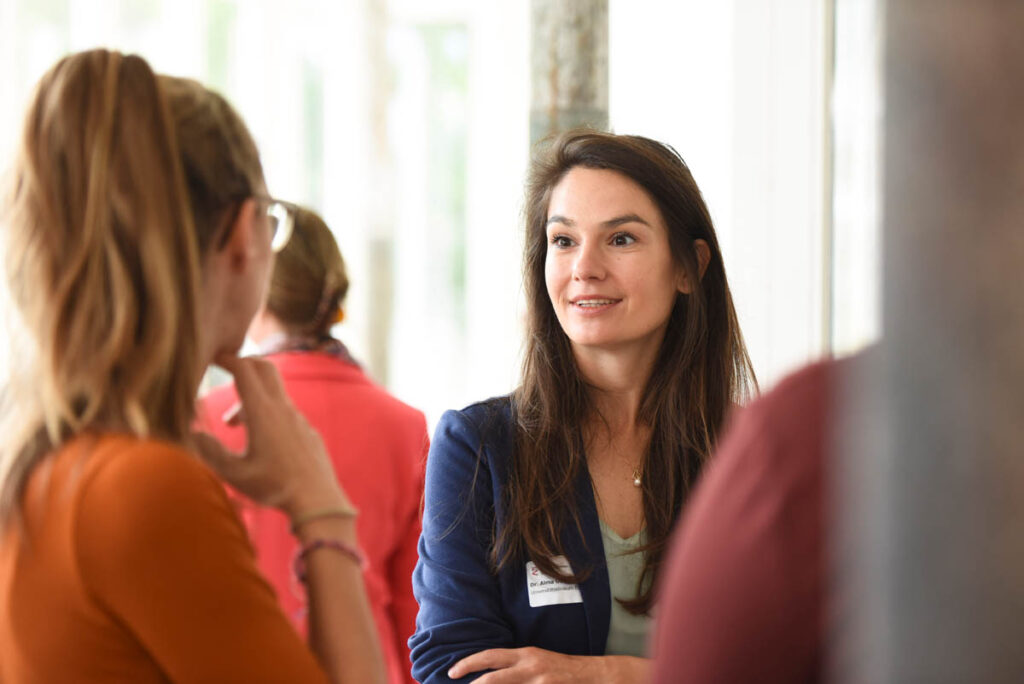
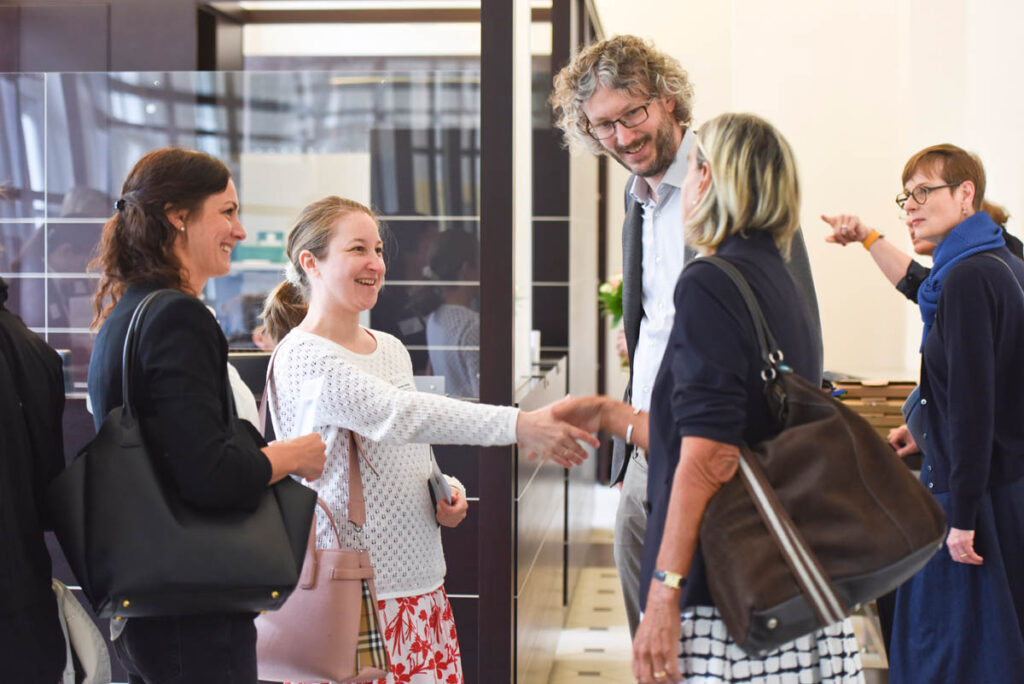
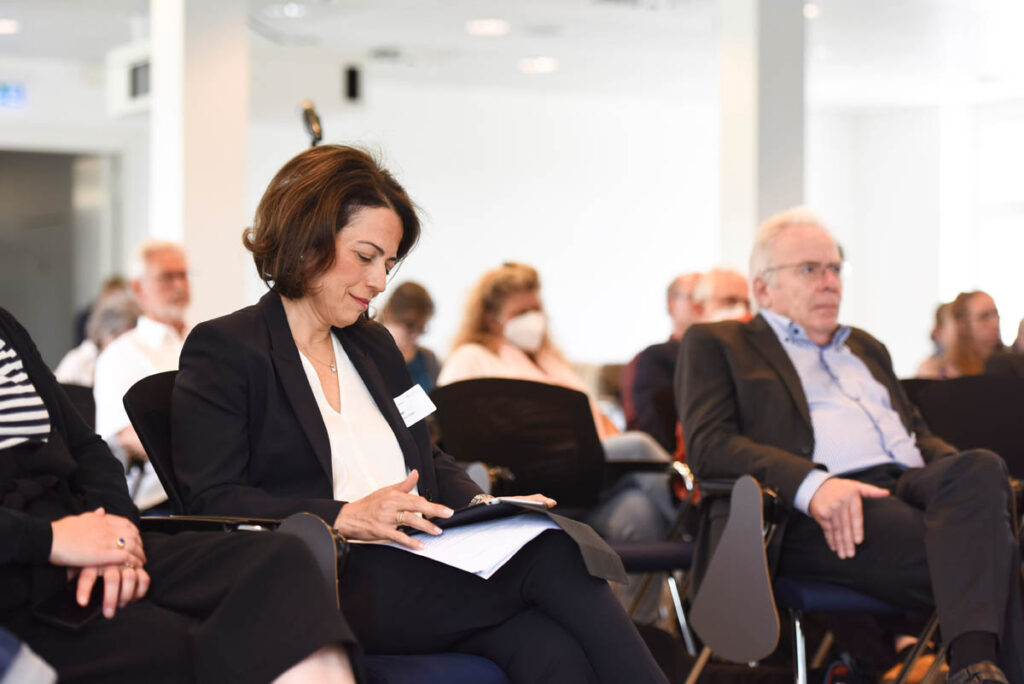
Prof. Dr. Stefanie Weber vom Bundesinstitut für Arzneimittel und Medizinprodukte (BfArm) richtete den Blick auf den Aspekt der Datenqualität in der Forschung. Um Seltene Erkrankungen in den Blickpunkt der Epidemiologie zu rücken, ist eine möglichst spezifische und eindeutige Kodierung notwendig, die durch die ICD-10-GM jedoch nicht gegeben ist. Dr. Weber erläuterte die Einführung der Alpha-ID-SE (Seltene Erkrankungen), mit der ab 2023 im stationären Bereich eine vereinfachte einheitliche und standardisierte Kodierung der Seltenen Erkrankungen nach der ICD-10-GM einerseits und der Orpha-Kennnummer andererseits implementiert wird. Sie zeigte auf, wie auf Grundlage der Orpha-Kodierung, die Information zu spezifischen Krankheitsbildern und darauf aufbauend die Qualität der Forschung und Versorgung verbessert werden können. Einigkeit bestand in der anschließenden Diskussion darüber, dass die Ausweitung der Alpha-ID-SE Kodierung auf den ambulanten Bereich, wo ein Großteil der Behandlungen stattfindet, dringend geboten ist.
Michael Byczkowski, Global Vice President und Leiter des Industriebereichs Gesundheitswesen bei SAP, gab anschließend einen Überblick über zentrale Technologietrends im Gesundheitswesen aus Sicht der IT-Industrie und beleuchtete Chancen und Herausforderungen der Verknüpfung von Daten zu Informationen. Er zeigte exemplarisch Einsatzmöglichkeiten von Softwarelösungen über den gesamten Behandlungspfad auf und skizzierte Ansätze, um Prozesse weiter zu automatisieren, datengestützte Entscheidungen zu ermöglichen und Mitarbeiter im Gesundheitswesen zu unterstützen. Ausgehend vom Zitat des britischen Mathemathikers Clice Humby, Daten seien das neue Öl, betonte er, dass auch bei Daten eine gute Aufbereitung notwendige Voraussetzung für die sinnvolle Nutzung ist. In der anschließenden Diskussion wurde deutlich, dass aus Sicht der Universitätsklinika noch mehr Bedarf für Zusammenarbeit mit der IT-Industrie besteht.
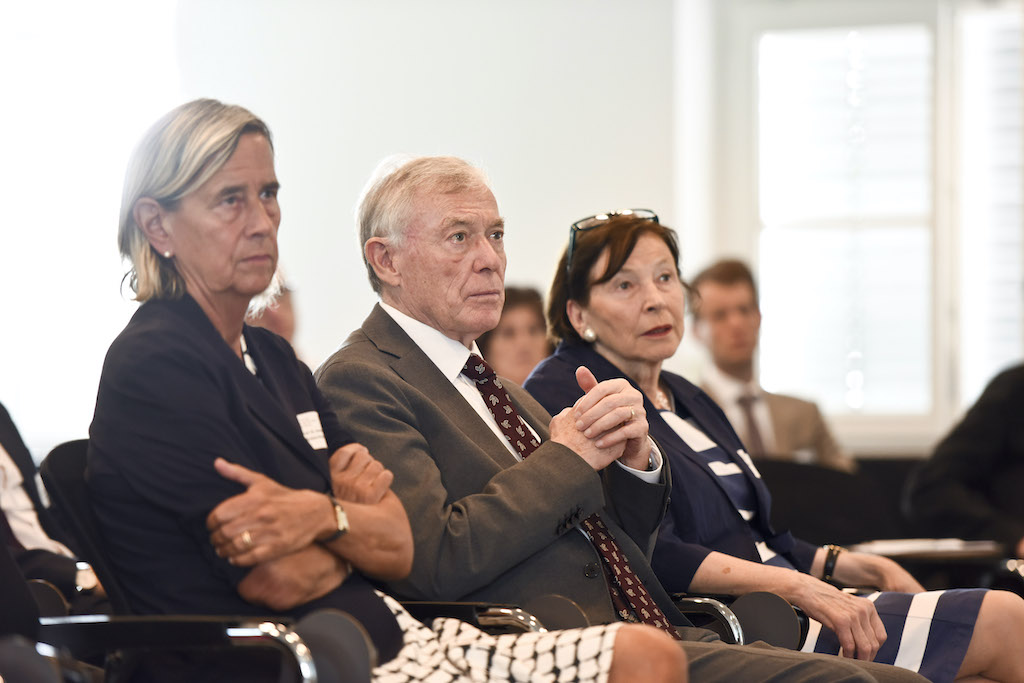
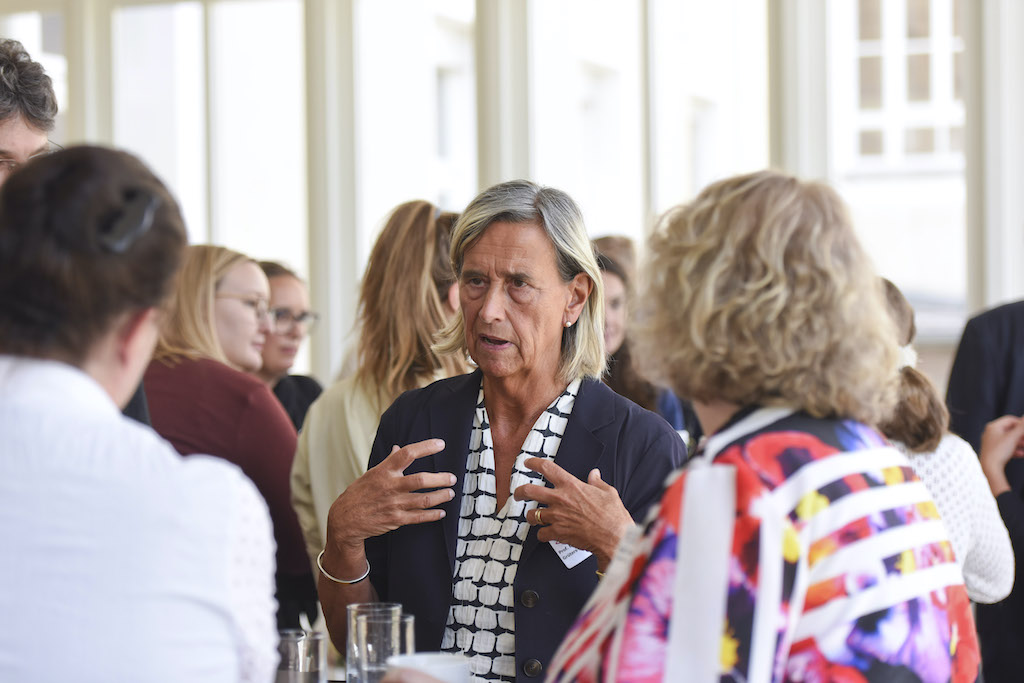
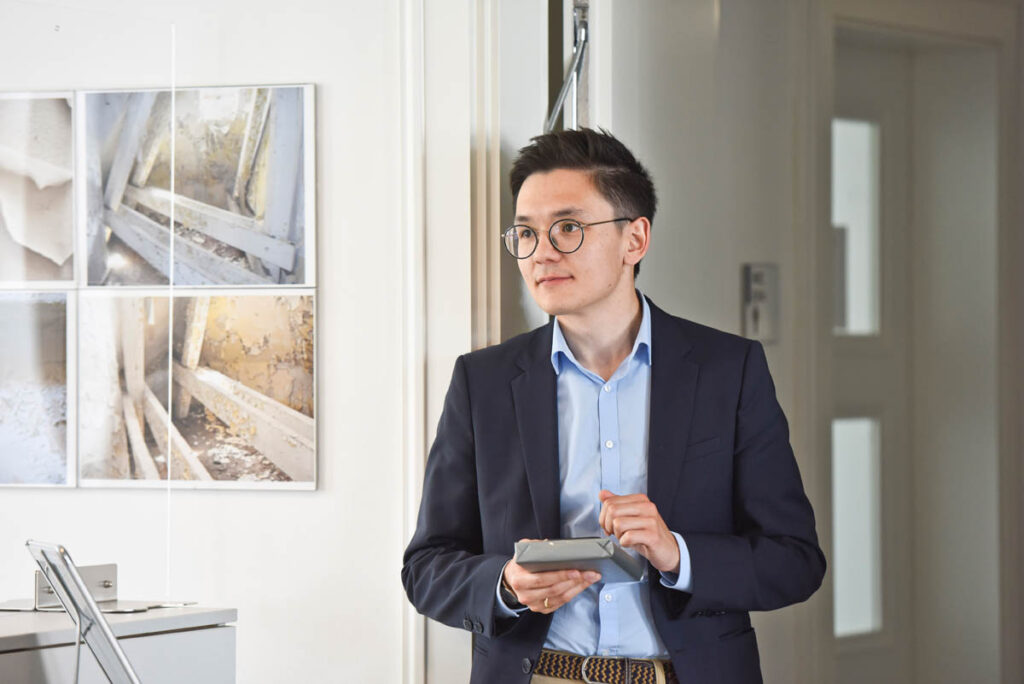


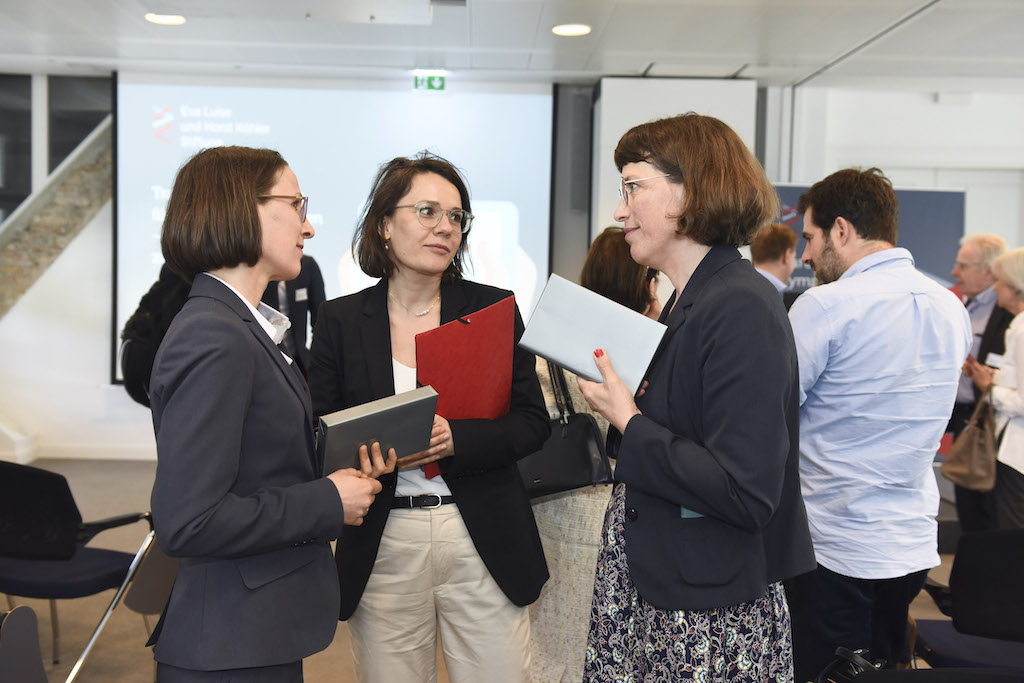
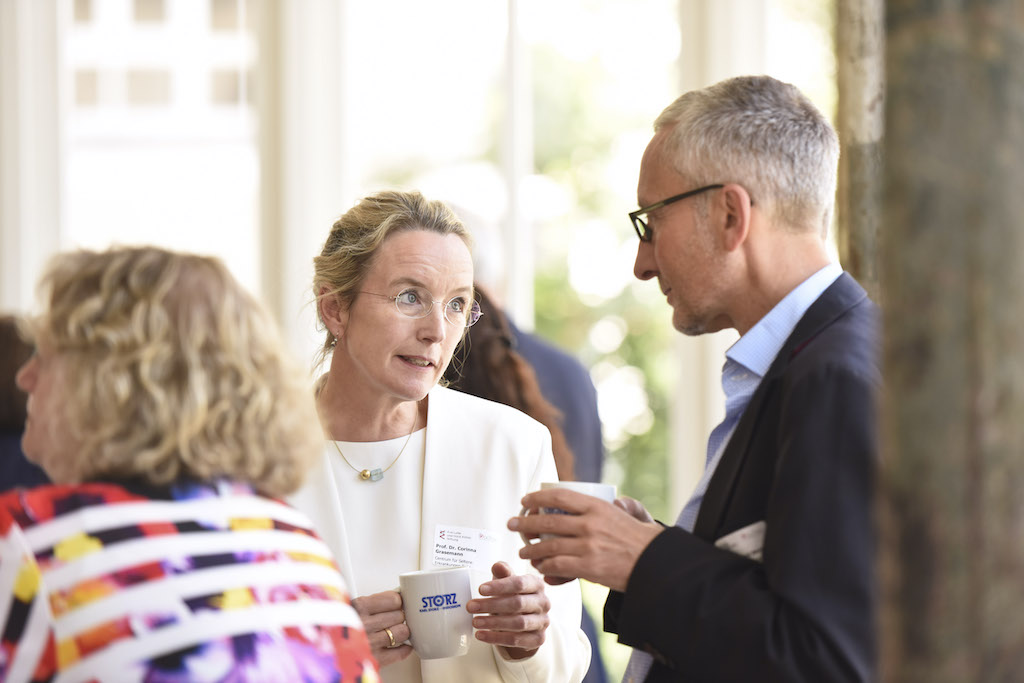
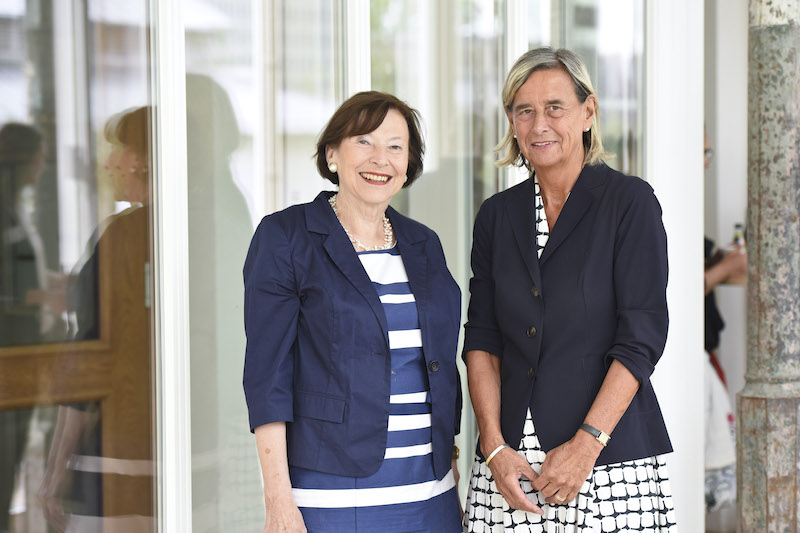
Auf die Diskussionen und Vorträge folgten bewegte und bewegende Bilder: In einem von der Grimmepreisträgerin Britta Wauer realisierten Filmprojekt der Eva Luise und Horst Köhler Stiftung geben 15 im Bereich der Seltenen Erkrankungen engagierte Menschen sehr persönliche Einblicke, was die „Medizin von morgen“ für sie konkret und für „die Seltenen“ allgemein bedeutet. Vier von ihnen standen anschließend in der von Sanna Börgel, Büroleiterin der Eva Luise und Horst Köhler Stiftung für Menschen mit Seltenen Erkrankungen, moderierten Gesprächsrunde zu einem vertiefenden Austausch bereit: Prof. Dr. Jutta Gärtner, Professorin für Kinderheilkunde am Universitätsklinikum Göttingen, Dr. Julien Park vom Universitätsklinikum Münster sowie Yvonne Möller und Jens Kiefer, Eltern von betroffenen Kindern, schilderten persönliche Erlebnisse mit Seltenen Erkrankungen aus Arzt- und Patient:innen-Sicht. Sie berichteten von Diagnosewegen, dem Umgang mit Gefühlen wie Unwissen- und Hilflosigkeit, aber auch Hoffnung und Freude. Deutlich wurde: Der Forschung hilft es, wenn Patientinnen und Patienten sowie Betroffene mit Forscher:innen Netzwerke aufbauen und so das Wissen um Krankheiten vorantreiben. Denn gemeinsam, Hand in Hand lässt sich jeder Weg leichter gehen.
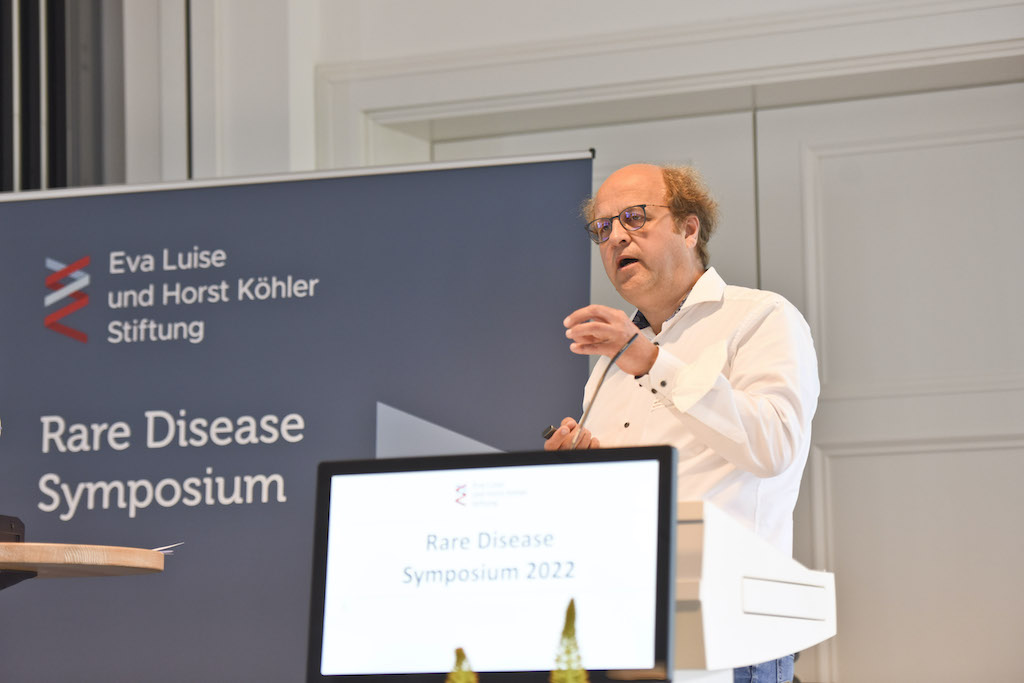
Der letzte Themenblock des Tages lenkte den Blick auf die Überführung der Forschungsergebnisse in die Therapie. Prof. Dr. Ger van Zandbergen, Leiter der Abteilung Immunologie im Paul Ehrlich Institut, zeigte auf, dass Biologika auch im Bereich der Seltenen Erkrankungen einen therapeutischen Ansatz mit stetig zunehmender Relevanz darstellen. Die Zahl der zugelassenen monoklonalen Antikörper, die erfolgreich in der Immuntherapie eingesetzt werden, ist rasant von 20 im Jahr 2010 auf 118 bis heute angestiegen. Für viele Indikationen, die bisher ohne Behandlungsoptionen waren, stehen somit Therapieansätze zur Verfügung. Auch im Rahmen von COVID-19 stehen monoklonale Antikörper zur Behandlung zur Verfügung. Zunehmend werden auch multi-spezifische Antikörper entwickelt, die gleichzeitig an mehrere an einer Erkrankung beteiligte Angriffspunkte im Körper binden können. Die Hoffnung ist, dass sich dadurch ein verbesserter Therapierfolg für die Patient*innen einstellt. Während Prof. Zandbergen zeigte, dass sich auch im Bereich der Seltenen Erkrankungen Studien randomisiert, multizentrisch, doppelblind und Placebo kontrolliert durchführen lassen, wurde in der anschließenden Diskussion sehr deutlich, dass dies nicht für alle Studien gelten kann und sollte.
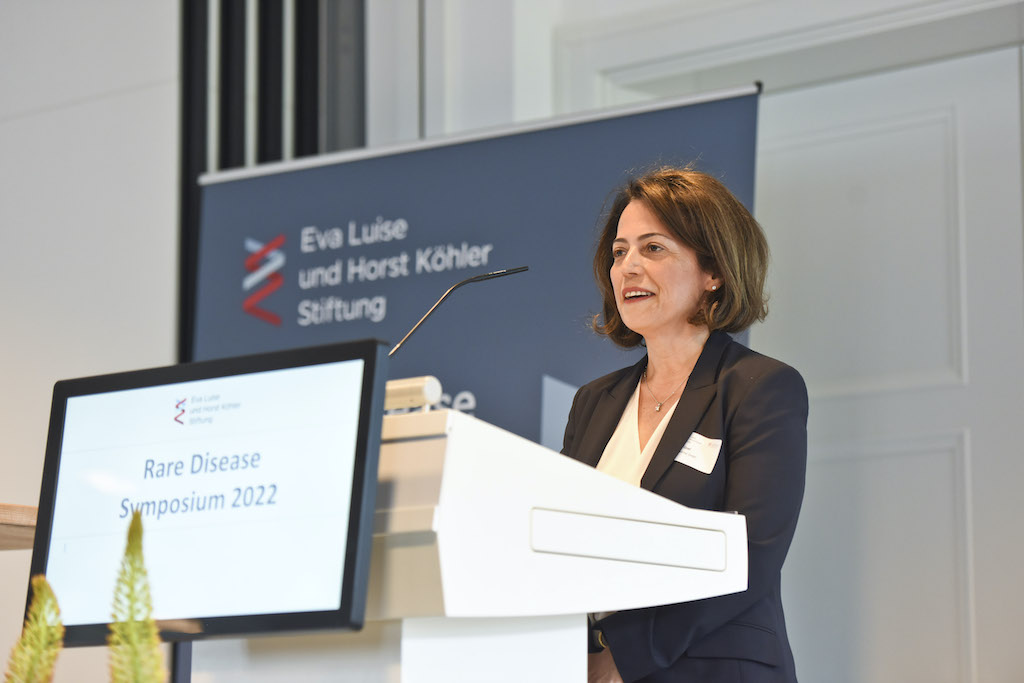
Im letzten Vortrag des diesjährigen Symposiums sprach Aylin Tüzel, Vorsitzende der Geschäftsführung der Pfizer Pharma GmbH über das Thema “Lessons from the covid 19 pandemic”. Anhand des Beispiels der schnellen und erfolgreichen Impfstoffentwicklung in Zusammenarbeit mit Biontech erläuterte sie die Notwendigkeit eines offenen und kooperativen Vorgehens, um durch gemeinsames Handeln möglichst schnell wirksame Therapien umsetzen zu können. Die Erfahrung aus der Pandemie zeige: “Wenn wir unsere Kräfte und Ressourcen bündeln, können wir Außergewöhnliches leisten.” Dazu müssten in Deutschland allerdings die Rahmenbedingungen für Forschung verbessert, Planungs- und Genehmigungsverfahren weiter beschleunigt und erleichtert sowie die Zusammenarbeit von öffentlicher und privater Forschung vorangetrieben getrieben werden. Abschließend legte Aylin Tüzel den Focus auf den Bereich der Prävention. Leicht zugängliche Präventionsangebote seien entscheidend, um das Gesundheitssystem zukunftsfähig zu machen und Freiräume für wichtige und notwendige Forschung in Bereichen wie den Seltenen Erkrankungen zu schaffen.
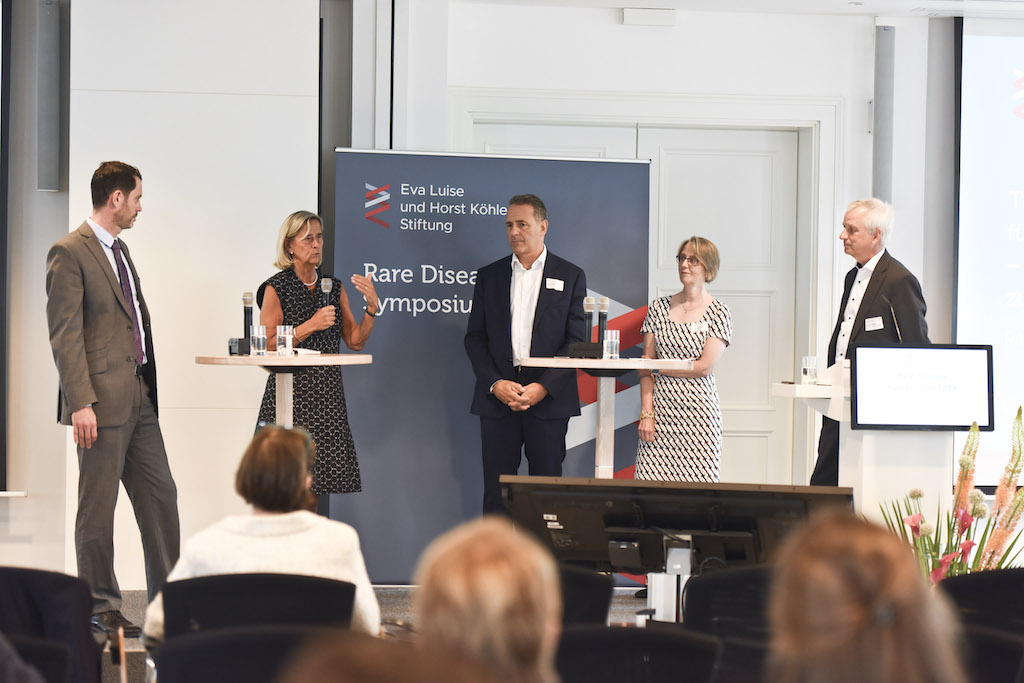
Zum Abschluss der Veranstaltung bat Frau Prof. Grüters Dr. Frank Wissing vom Medizinischen Fakultätentag, Dr. Matthias Wilken vom Bundesvorstand der Pharmazeutischen Industrie, Prof. Hildegard Büning von der Medizinischen Hochschule Hannover und Jean Luc Delay, General Manager von Takeda für einen Austausch zum Thema “Academia und Industrie – Neue Wege der Zusammenarbeit” auf die Bühne. Einigkeit bestand darüber, dass die Seltenen Erkrankungen keinen Raum für Wettbewerb und Alleingänge bieten, sondern eine umfassende Vernetzung aller Akteure erfordern. Um diese Zusammenarbeit zu intensivieren, müssen Forschung, Industrie und Politik regelmäßig an einen Tisch gebracht werden, etwa im Rahmen von Think Tanks und Symposien wie diesem. Betont wurde, dass eine erfolgreiche Zusammenarbeit sowohl Räume als auch Zeit braucht. Forscher dürften nicht nur in Publikationen, die Industrie nicht nur in Patenten denken. Vielmehr müssten beide Welten bereits frühzeitig miteinander verknüpft werden, damit aus Forschung auch wirklich Gesundheit werden kann.
